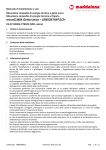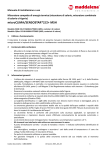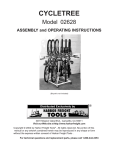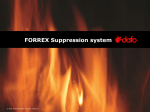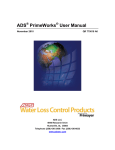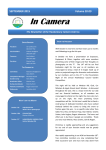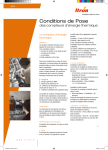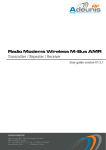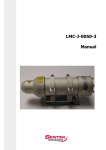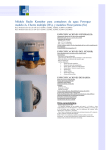Download RealSens™ datasheet here
Transcript
RealSens is certified by the South African National Regulator for Compulsory Standards (NRCS) 1 CONTENTS PAGE 1. About RealSens™ 2. RealSens™ system architecture 4. RealSens™ communication technology 5. RealSens™ system components 6. Attributes of the RealSens™ system 7. RealSens™ technical specifications 13. Installing the RealSens™ system 17. Operation and maintenance of the RealSens™ system 18. Associated products 19. Certifications (CE, ISO, SABS, NRCS, etc.) 20. Safety & Environmental Precautions ABOUT REALSENS™ RealSens™ is an Advanced Metering Infrastructure (AMI) system. It is a robust metering, communication and control system turning utility distribution infrastructure into “smart grids” by integration of remote meter data with conventional back-office systems via a cloud-based database. This is achieved through its high-tech, low-cost data acquisition and secure communication capabilities which is based on a bi-directional, license-free, ultra-low-power, radio frequency mesh network, integrated with GSM, Fiber Optic or WI-FI networks. Meter readings with intervals as frequent as 1 minute (normal settings: ½-hourly, hourly or daily), read on demand, time of use (TOU) and active leak monitoring are but a few features of RealSens™. Add to this the ability to control devices in the field from the comfort of your office, as well as accessing your own data on the Internet, and you own a true AMI system. RealSens™ was developed to meet the specific demands of water utilities, which are generally more onerous than the technological and operational demands of electricity utilities, where power and communications are readily available at the meter. The demands of water utilities resulted in a specific technology choice and product design, to deliver a long-life battery operated system, independent of an external power supply source, incorporating a built-in communication system that is low cost, yet robust and reliable, even in the harshest environmental conditions. By meeting these demands, RealSens™ can be classed as a fully multi–utility system whether it is water, gas, electricity, or renewables. RealSens™ now offers smart grid capability at lower cost than first generation walk-by and drive-by technologies. RealSens™ delivers truly intelligent, remote metering and control capabilities that can be utilised for: infrastructure management; load shedding; customer services; regulatory reporting; credit management; time-of-use reports; flow logging; utility demand management; distributed generation and a multitude of infrastructure and business planning functions that older or lesser technologies cannot deliver. Under certain circumstances it is necessary to commence a metering automation process with a walk-by drive-by (WBDB) system, for example such as when meters are not simultaneously available in a dense and contigious geographical area, for connection to a remote metering system. For situations like this, RealSens™ is available as a super-efficient WBDB system, in which the need for complicated and expensive route planning software is not required. This WBDB mode of RealSens™ can easily be transformed into a fixed mesh network system when the density of meters connected to the RealSens™ system justifies it. The capabilities of RealSens™ make it an automatic choice as a tool for resource demand management. Data previously not available to utility managers is now a push of a button away for prompt decision making, reporting, billing and planning. RealSens™, unlike many other systems, actually utilizes the bi-directional communication capability, in a similar way that SCADA (supervisory control and data acquisition) systems do. This true bi-directional communication capability and proven reliability under harsh environmental conditions, make RealSens™ the leader in low-cost “smart grid” solutions, also for water utilities. RealSens™ was developed over the past decade by paying careful consideration to customers’ needs. A multi-disciplinary team of specialists from the fields of water and power utilities, electronics & radio communications, software development, data management and business process design, responded to these needs, and following extensive technology research and field trials, the system was released. The same team is still listening and responding to the customers’ needs, which provides RealSens™ with its futuristic capabilities. RealSens™ is distributed worldwide by Reonet. RealSens is certified by the South African National Regulator for Compulsory Standards (NRCS) 1 REALSENS™ SYSTEM ARCHITECTURE First Generation AMR The first step towards intelligent metering was driven by the need to improve the numerous shortcomings in the traditional approach to utility meter reading. The difficulties associated with access to meters, occupational health and safety (OHS) issues, inaccuracies inherent in manual meter reading, the need for special reads and the cost associated therewith, begged for the development of a more efficient system. The first generation intelligent metering technologies were designed to overcome these specific difficulties, which led to the development of walk-by and drive-by systems to supply one reading per meter per month, just like the manual reading system. Walk-by and Drive-by (WBDB) Metering Systems In WBDB systems, meter readings are retrieved through a Radio Frequency transceiver, usually in the 434, 868 or 915 MHz ISM (industrial, scientific and medical) frequency bandwidths, which sends metering information wirelessly to a handheld unit while the meter reader walks down the road. The RF transceiver at the meter is usually of a “sealed for life” construction and can be used in above or below ground applications. Other variations such as the Touchpad System are also still employed at a smaller scale. Drive-by systems allow for more rapid meter reading than walk-by systems, resulting in a more efficient solution for meter reading and billing. Utilising a similar meter and transceiver installation set-up as with walk-by, the drive-by system incorporates a more powerful vehicle-based data collection transceiver. Meter reading software normally includes a route management program, creating a route for the meter reading vehicle to follow. Later versions of WBDB systems can log meter readings at much smaller time intervals (e.g. ½-hourly) but is still only transmitted to a handheld receiver when it downloads the data from close proximity. The 2 RealSens™ version of WBDB does not require route planning software because it automatically links the meter GPS co-ordinates to a unique radio address, which in turn is assigned to the meter interface unit (MIU), the meter serial number and associated meter, property and consumer details. Second Generation AMR Second generation intelligent metering technologies make it possible to receive meter readings directly from the meter on an office computer, eliminating any walkor drive-by. This is achieved by installing fixed radio networks or wired communication systems, with the ability to upload meter readings at pre-programmed intervals to data concentrators from where the readings are forwarded to management systems. These systems are characterised by one-way communication capability making read-on-demand impossible. The communication media used for these systems include power line carrier with mixed success, optic fibre, radio and GSM data transmission. Third Generation: AMR to AMI The third generation intelligent metering was born out of recognition of the need for two-way communication with utility meters, to obtain special reads on demand and to perform limited control functions on utility devices. These systems are referred to as Advanced Metering Infrastructure (AMI) systems. The two-way communication systems used for AMI systems also include power line frequency modulation, optic fibres, radio and GSM data transmission, although the effective utilization of two-way communication for large scale deployments remains a challenge for most system developers. Fourth Generation: AMI to RealSens™ Smart Grids transcend meter reading as it has been understood before. Smart Grids refer to utility distribution infrastructure that is equipped with meters, devices, communication infrastructure and Data Sheet: Advanced Metering Infrastructure System management systems, which render the distribution grid intelligent. This is achieved by providing realtime or near-real-time information, automatically or on demand, to utility managers, for the management, planning and control of the distribution infrastructure. The term smart grid was initially coined for electricity distribution infrastructure. It specifically implies the capability to manage the load profile of the grid to better manage exception conditions. Smart grids also provide powerful and rich information for grid expansion planning, statutory reporting, operational improvement planning, increasing operational efficiencies and it offers a comprehensive suite of customer services. Smart Grids for water utilities were, until recently, not a viable proposition, from a cost, reliability, and technology availability point of view. RealSens™ now offers cost-effective smart grid capabilities, by integrating radio and GSM technology, and it exploits the full bi-directional communication potential of this systems architecture. A powerful cloud-based database adds the final touches to a highly advanced system. The RealSens™ system architecture is depicted in the figure below. RealSens is certified by the South African National Regulator for Compulsory Standards (NRCS) 3 REALSENS™ COMMUNICATION TECHNOLOGY At present, four categories of communication technologies dominate the AMR/AMI/smart metering/ smart grid space. The technologies are closely linked to the functionality of the system, for example, walkby and drive-by systems employ short-range radio frequency technologies, whereas more modern AMR, AMI and smart grids are based on integrated radio frequency (RF) mesh networks, long-range fixed RF networks or hard-wired communication systems. RF fixed mesh network RealSens™ employs the technology of an RF fixed (mesh) network that connects to pervasive communication systems such as GSM/GPRS through the RealSens™ RF/GSM Gateway device. Unlike long-range, star-configured fixed networks, RF mesh networks employ ultra-low-power two-way transceivers operating on shorter range, licence-free RF bands within the ranges 433MHz, 868MHz or 915MHz, also known as the industrial, scientific and medical (ISM) frequency bands. RealSens™ operates in the 868MHz bandwidth. It provides all the functionality to operate as an AMI system, but at lower cost than long-range fixed networks, and it overcomes some limitations of the long-range, star-configured fixed radio networks. For example, integrated RF mesh networks do not require pre-licensing or operational licensing. It also does not pose any health hazards due to electromagnetic emissions, thanks to the ultra-low power output. The RealSens™ communication protocols eliminate the risk of data loss. Some of the communication protocols include frequency-hopping and smart listening and identification algorithms. RF walk-by, drive-by (WBDB) system RealSens™ can also be implemented as a walk-by, drive-by (WBDB) system. In this implementation, only the RealSens™ meter interface units (MIUs) are required to be installed. The WBDB system can later be expanded into a fixed mesh network simply by adding RealSens™ Repeaters and RealSens™ Gateway devices. The RealSens™ WBDB implementation does not require route-planning software because it automatically links the meter’s GPS co-ordinates to a unique radio address, which in turn is assigned to the MIU, the meter serial number and associated meter, property and consumer details. Meter readings are collected by a handheld portable device running the RealSens™ Sync software. Computer screen image of typical F/N topology 4 Data Sheet: Advanced Metering Infrastructure System REALSENS™ SYSTEM COMPONENTS The RealSens™ RF system connects to meters or endpoint devices. The metering data is transmitted to a cloud-based database from where the data is available for back-office systems that produce information and drive processes. RealSens™ communicates with most utility meters and devices, provided they are equipped with an output interface. It is fully compatible with contact closure reed probes, electronic or inductive pulse emitters or an industry-standard 4-20 mA output. The first and very important part of the system is the meter and its data output capability to which the RealSens™ transceiver is connected. In order to ensure that RealSens™ is connected to meters and sensors that are of adequate quality and compatibility, a field audit process precedes the RealSens™ installation process. To streamline and standardise the quality and effectiveness of the audit process, the RealSens™ team developed productivity- and quality-management software, which also supports system configuration and meter reading synchronisation. The RealSens™ Sync software, which was developed as an aid in this process, is also used in the WBDB implementation of RealSens™ to collect meter-reading data. This software can be installed on most Windows mobile handheld devices. RealSens™ Meter Interface Units (RS-MIU) connect by data cable to the meter output interface. Each MIU can accommodate up to four channels, allowing four meters to be connected to one MIU. RS-MIUs are housed in half-spherical enclosures that are rugged and waterproof to IP68 standard. The RealSens™ Repeaters (RS-Repeater) operate as range extenders and are designed so that they can be strapped to lampposts or fixed to flat vertical walls. The long battery life and rugged construction makes the RS-Repeater a maintenance-free installation and its small profile renders it unobtrusive. The RealSens™ GSM Gateway (RS-Gateway) acts as a router between the RF mesh network and the GSM network. The Gateway unit can “wake up” the selected MIU and communication path components, from which data can be requested on demand. The RS-Gateway is housed in a rugged outdoors enclosure. It requires an external power source, which could include solar power, and it is optionally equipped with a standby battery that will operate the unit independently in case of mains power failure. RealSens™ Manager (RS-Manager) is a powerful software suite that remotely configures and manages the entire radio mesh network. RS-Manager continually monitors the RealSens™ system behaviour and it automatically reports any system problems, such as signal strength, “no reads” at scheduled times, tampering, leaks on consumer properties, or any other anomalous behaviour. RS-Manager automatically manages downloads at preset intervals. The RealSens™ GSM Gateway transfers data to a cloud-based database (RS-DB) by establishing a direct connection to the server through an access point name (APN) via GSM/GPRS. Once connection is established to our cloud server, data is transferred using the RealSens™ server, which will then store each reading in the database. This data can be either exported or imported to other systems through various file formats, e.g. Excel, CSV, ASCII, Text or direct database access. These systems can be meter data management systems (MDMSs), billing systems, reporting systems, geographical views in Google Earth™, network management systems, geographic information systems (GISs) in Google Earth™, maintenance systems or consumer information systems (CISs). RealSens is certified by the South African National Regulator for Compulsory Standards (NRCS) 5 ATTRIBUTES OF THE REALSENS™ SYSTEM • RealSens™ is highly suitable for connection to existing metering infrastructure that contains a large variety of meters of different sizes, types and ages, from different manufacturers • RealSens™ is proven to withstand the harsh outdoor environmental conditions at water utilities, where it has been subjected to rigorous field tests • It offers smart grid capabilities for all utilities, at a lower cost than most drive-by AMR systems • It is capable of measuring water, gas, electricity, temperature and any industry standard 4-20mA signal • The four-channel RS-MIUs increase costeffectiveness. A mains-powered 16-channel MIU is under development. This would be a cost-effective technology to connect to a large number of electricity meters in close proximity (meter box) and will be able to stream data for control purposes • The system is entirely driven through user-friendly interface applications (web-based or workstationbased), linked directly to a cloud-based database • RealSens™ uses the proprietary global utility management protocol (GUMP) • RealSens™ MIUs, Repeaters and Gateway geographical locations and signal strength can be viewed with Google Earth™ • RealSens™ provides for leak reporting at consumer meters, based on customisable “leak thresholds” • It has an easy, secure web-based user interface for viewing meter readings and for report creation • RealSens Sync can be used for pre-installation planning and post-installation quality control, through field audits or by providing real-time meter index comparison capabilities • RealSens™ is as suitable for multi-utility submetering in buildings as it is for remote rural utilities or very large urban utilities • RealSens™ is highly scalable and is well suited to a phased implementation The bi-directional communication capability of RealSens™ allows it, amongst other things, to: • Instruct individually selected MIUs to log consumption data at different sample rates • Obtain “special reads” in real time • Remotely configure and maintain the integrated RF mesh network and remotely synchronise meter readings with the metering database • Close or open circuit breakers, or shut and open valves – thereby allowing a remote credit-control capability, either as prepaid or credit meter • Remotely control entire utility networks through closing and opening circuit breakers or isolating valves 6 RealSens Meter Data Management and Web-based Reporting System Data Sheet: Advanced Metering Infrastructure System REALSENS™ TECHNICAL SPECIFICATIONS General system specifications • Designed for reliability, simplified low-cost installation, ultra-low power usage and robustness • Remote configuration and system operation from friendly user-interfaces and cloud-based database server • Ultra low power and “long-range” wireless technology with significant power advantages over other systems • Real-time bi-directional communication capability, allowing for the control of endpoint devices • Easy network/device setup using GIS technologies that can be carried out remotely • RealSens™ does not restrict the number of endpoints that can be connected within a mesh network • Long battery life with local life monitoring (>10 years – normal operation) • Narrow band RF communications • Operates in 868 MHz ISM frequency (major worldwide license free frequency) • The mesh network can accommodate up to 5 repeater hops • ETS300-220, FCC part 15 compliance (certification ready) • RF power output 32 mW, +15 dBm for individual devices • Programmable output power from 0 dBm to +15 dBm (32 mW) (5 dBm steps) • Automatic Frequency Error Correction • Sensitivity control can be manually set • Adaptive Frequency Hopping • Continuous phase 2-level FSK modulation using Frequency Hopping Spread Spectrum (FHSS) techniques • Receiver standby algorithms to reduce power consumption • Various security algorithms available on request • Quality of service management • Fast RSSI detection (Received Signal Strength Indicator) provides signal strength for both directions of data communication at each hop MIU connected to meter • Fully managed data packet routing algorithms allowing identification of failed segments of backbone, etc • Frequency switching at various positions on the RF Mesh network to avoid unnecessary waking up of unneeded devices, thus ensuring longer battery life • Large number of deployment / installation tools such as automatic network configuration, based on GIS and live signal strength analysis RealSens is certified by the South African National Regulator for Compulsory Standards (NRCS) 7 RS-Pulse specification The RS-Pulse is an ultra low powered electronic switch that replaces less reliable mechanical reed switches. RS-Pulse makes use of electronic Hall Effect technology. • Produces an accurate pulse count output through intrinsic hysteresis that eliminates switch bounce • Suitable for connecting to most magnetic pulse meters • More robust (less prone to damage during installation and operations) • Accuracy not impaired by vibration and temperature fluctuations • Sensor housing is equipped with interlocking guide to ensure optimal positioning for accurate pulse pickup Pulse sensor and MIU Data connector nodes for RS232 output RS-Pulse Hall-effect pulse pick-up sensor 8 Data Sheet: Advanced Metering Infrastructure System RS-MIU specification The RS-MIU is a small, battery operated, radio transceiver designed to be situated at the meter and accept the pulse input from any AMR compliant meter. Its function is to locally track and record the consumption pulses, as well as monitor leak and tamper conditions. • Monitors up to 4 pulse inputs • Tracks the index readings on a continuous basis • Records and stores up to 720 index readings (FIFO data logging) for later downloading. Data logging takes place at specific times and intervals that are configurable, enabling a snapshot look that allows for accurate consumption balancing calculations • Monitors consumption on an hourly basis and flags the presence of a residual leak conditions • Detects cable cut conditions • Provides diagnostic functions by means of 2 pushbuttons and 4 LEDs • Robust, attractive, low-profile IP68 rated water-proof enclosure • Replaceable batteries (>10 yrs lifespan under normal operating conditions) • Withstand 600kg vertically induced load • No data loss when radio network goes down • 868 MHz ISM frequency band RS-MIU with top screwed on (left) and off (right), showing PC board with RF antenna and diagnostics buttons RS-MIU underside, showing four-channel data cables RS-MIU component schematic diagram RealSens is certified by the South African National Regulator for Compulsory Standards (NRCS) 9 MIU Data with connectors MIU Base with PC Board 10 Data Sheet: Advanced Metering Infrastructure System RS-Repeater specifications RS-Gateway specifications The RS-Repeater is a battery-operated small radio transceiver, the purpose of which is to extend the mesh network range. The RS-Gateway is essentially a router that connects the RF mesh network to the GPRS/GSM network. • Robust IP68 sealed housing, designed to be attached to a building or strapped to a pole • Replaceable battery (>10 years lifespan under normal operating conditions) • 868MHz ISM frequency band RS-Repeater, showing fixing lugs for strapping or screwing fasteners • Powered by mains power or solar panel • Manages SIM card and PIN code functions • Automatically maintains connection to the GPRS/ GSM network • Maintains an open connection to the RS-Server • Monitors network status through a “heartbeat” system • Provides diagnostic information by means of an onboard LCD display • 868MHz ISM frequency band RS-Gateway GSM unit showing RF and GSM antennas RS-Gateway GSM unit showing RF and GSM antennas RealSens is certified by the South African National Regulator for Compulsory Standards (NRCS) 11 RealSens™ Sync specifications RealSens™ Sync is the software that provides the walkby, drive-by (WBDB) meter-reading capabilities of the RealSens™ system. RealSens™ RealSens™ Sync also assists with the installation and maintenance of the RealSens™ system. • Runs on Windows Mobile 5 or later • Provides all WBDB download functionality • Establishes secure bi-directional communication with nearby MIUs • Reads and validates meter index • Checks strength of radio signal • Checks and corrects pulse weight of meter pulse output • Synchronises MIU with meter reading • Performs system diagnostics • Provides system configuration tools • 868MHz ISM frequency band RS-Manager specifications RS-Manager is the software that drives the RealSens™ system. It provides the tools for: • • • • Setup and configuration of devices on the network Management of the RealSens™ system Diagnostics and utilities Collection of meter-reading data and insertion into the cloud database • Database management • Importing and processing WBDB meter-reading data from RealSens™ Sync RS-Sync software on PDA Weights and sizes Weights and dimensions of RealSens™ components: Dimension and weight 12 Component RS-Probe RS-MIU RS-Repeater RS-Gateway Weight (gm) 10 430 198 200 Length (mm) 47 - - - Width (mm) - - 38 24 Height (mm) - 48 269 99 Diameter (mm) 5 100 - - Data Sheet: Advanced Metering Infrastructure System INSTALLING THE REALSENS™ SYSTEM With RS-Sync, field auditors can verify the quality and other parameters of the installed meters, the correctness of the installation, and the compatibility of the signal output facility to be connected to RealSens™ transceivers. The audit process team can also provide independent advice to utility managers regarding the field-tested performance of utility meters. The utility company or its contractors should first replace and/ or reinstall all meters and devices that were found to be of inadequate standard, quality or compatibility, or incorrectly installed. RealSens™ can be installed as either an RF F/N mesh system or as an advanced WBDB system. Installation procedures for the Meter Interface Units (MIUs) are exactly the same for the RF F/N mesh system and the WBDB system. The installation of the RF F/N mesh system will be discussed below. A comprehensive RealSens™ User Manual (RSUM) has been developed for installers, operators, maintenance staff and data management staff, for the effective installation and management of the RealSens™ system. An RSUM is available for all clients who wish to install and manage their own RealSens™ system. The RealSens™ system is otherwise installed, operated and maintained by licensed implementers such as Reonet. The licensed implementers can also provide a suite of utility management services and solutions that are underpinned by the RealSens™ AMR system. These services and solutions include: 1. Meter data management services 2. Automated web-based utility billing 3. Automated web-based utility reporting Meter audits • The suitability of the installed meter (is it AMR compatible, is it of good quality and accuracy, is it correctly installed, is it serving the correct consumer, etc.) • The communication modules of the meter (this determines the type of data connection (pulse or data), the pulse weight, no. of outputs, units of measure, tariff applicable, etc. • The locality of the meter (GPS co-ordinates, property Surveyor General details), accessibility • Meter details (size, manufacturer, model, serial number, meter reading, current transformer sizes – if applicable, circuit breaker sizes, programmable meter, meter ownership, etc.) All of the above-mentioned data, captured during the meter audit phase, is imported into the RSManager system. RS-MIU installation The RS-MIU can be installed indoors, outdoors (below or above ground), inside housings containing the meter, or inside meter chambers with a concrete lid. The RS-MIU can have up to four channels with cables up to three metres long. Each channel can connect to meters either by hardwiring into a meter’s output terminals, or to a pulse pickup (inserted or attached). When the RS-MIU is installed, all relevant data pertinent to that installation is captured on the handheld device loaded with the installation software. This includes data such as RS-MIU unique radio address, unique meter number, GPS co-ordinates and pulse weight. Synchronisation of the actual meter reading to the RS-MIU occurs at the final stage when the system is configured. Prior to installation of the RealSens™ system, it is necessary to conduct a meter audit, the purpose of which is to determine the following: RealSens is certified by the South African National Regulator for Compulsory Standards (NRCS) 13 Variable (determine on site) 132mm dia. hole augered through concrete/asphalt Steel lid 110mm dia. PVC pipe with screw-on endcap Concrete/ Asphalt 20mm dia. hole drilled and fitted with 15mm dia. PVC duct Polystyrene Sand MIU Data Cable threaded through duct 110mm dia. PVC sleeve slotted into auger hole Above and below: typical below-ground (meter well) installation of an RS-MIU inside a sealed 110-diameter PVC pipe with thermal insulation R n e a l S e s s n e a l S e s R R n e a l S e 14 Data Sheet: Advanced Metering Infrastructure System RS-Repeater installation The RS-Repeater is a range extender and an RF mesh network-building component. RS-Repeaters should be installed at high points in the network area, so as to offer the best transmission capability for signal coverage. RS-Repeaters are commonly attached to lamp posts, telephone poles and flag poles or affixed to buildings. RS-Gateway installation The RS-Gateway is the device that connects the RF mesh network to the GSM network, in other words, the RS-Gateway acts as a GSM-RF router. RS-Gateways are connected to a 12V DC – 1.5 Amp power supply. RSGateways should always be installed indoors, but when it has to be installed outdoors it should be enclosed in a water-resistant enclosure with an IP rating of at least 65. Water (F/N and WBDB) installation All relevant information about the meter, data channel, MIU, radio address, GPS co-ordinates, property description, etc, should be captured through a job card system in order to ensure that the relevant data is imported into and maintained by RS-Manager and RSDB. A predetermined list of fields must be captured on the job card system, in order for the fixed network to be built. This information can later be used for fault finding and troubleshooting. A post-installation audit must be undertaken within a day to a week after installation (timing dependent on the size and consumption of the meter) to ensure that the meter readings as reflected in RS-Manager, correctly tracks with the meter readings on the face of the meter. In order to install a RealSens™ MIU on a water meter, information about the meter is required. The meter manufacturer, model, size and type will dictate the type of pulse pickup to be used with the meter. Pulse pickups can either be supplied by the meter manufacturer (HRI Mei, HRI, RD01, Actaris Cybels) or from RealSens™. The RealSens™ pulse pickup (RealSens™ Probe) is a solid hall-effect sensor (no moving parts) and is available for most mainline meters. In some instances a computer and software are required for programming the meter manufacturer’s pulse pickups. The pulse pickup is connected to the RS-MIU in accordance with the applicable manufacturer’s connection diagram. Placement of the RS-MIU must be determined before it is connected, so as to limit exposure to vandalism or the accidental damage of cabling and the RS-MIU. Once the RS-MIU is installed, its screw-on lid needs to be removed and the unit needs to be switched on. The RS-MIU is now ready to be synchronised with the reading of the meter to which it is connected. It is important to note the pulse weight of the different meters or pulse pickups, as this will ensure that the ongoing meter reading values on the RS-MIU and RS-Manager are correct. Examples of typical pulse pick-up connections to domestic-sized water meters RealSens is certified by the South African National Regulator for Compulsory Standards (NRCS) 15 Electricity (F/N & WBDB) installation For electricity meters, the RS-MIU data cable can be connected directly to the meter’s output interface. Furthermore, if it is a programmable meter, the meter would need to be re-programmed with a meter scheme set-up, using the meter manufacturer`s proprietary software. Some meters need modifications done on the electronic board, in order for the RS-MIU to receive the output pulse. The remainder of the installation procedures is essentially the same as for water meters. Network building and configuring (F/N) Once the relevant data from the job card fields have been inserted into RS-Manager, the RS-MIU positions are plotted on a Google Earth™ background. With the aid of the Google Earth™ tool, the RF technician employs his knowledge of the site to set up the RF fixed mesh network topology. In this scheme, the RS-Gateway is placed as close as possible to the geographical centre of the installed RS-Repeaters and RS-MIU’s. A sufficient number of RS-Repeaters must be installed in close enough proximity to MIU’s to ensure that adequate signal strength is maintained between the devices. It is important to note that only five repeater hops are available before the signal must enter the RS-Gateway. A predefined list of fields must be captured on the job card system in order for the fixed network to be built. All RS-MIUs and RS-Repeaters are thereafter ready for configuration on the network. A data SIM card, supplied by a cellphone provider, must be inserted into the RS-Gateway and then activated, whereafter it is provisioned on an APN network. The RF power and sensitivity settings as well as a few other parameters must be set to ensure optimum communication. It also includes the synchronisation of the actual meter reading with the RS-MIU, in order for the meter reading values in RS-Base to be the same as those reflected on the face of the meter. Operation and maintenance of the RealSens™ system RealSens™ is operated differently when used as an RF F/N mesh system as opposed to when it is used as a WBDB system. The comprehensive RealSens™ User Manual (RSUM) describes how RealSens™ should be installed and operated in the two different modes. A short summary is provided below. Schematic diagram of the RealSens™ components in a fixed mesh network configuration showing five repeater hops 16 Data Sheet: Advanced Metering Infrastructure System OPERATION AND MAINTENCE OF THE REALSENS™ SYSTEM Operation and maintenance – F/N RS-Sync software on a handheld mobile computing device or personal digital assistant (PDA) is used for many operational and maintenance functions. Before RS-Sync can be used on site for operation and maintenance, the latest zone lookup file must be uploaded to the PDA. Using the RS-Sync software, the following should be done daily: Check the “Collection attempt” column for communication failures. After six collection-attempt failures, a forced download on that device must be triggered to confirm if there is a communication error. On a weekly basis it is neccassery to conduct a forced download (using RS-Sync) on all MIUs. This will download the necessary data records to provide a snapshot of the network communications and will identify devices that are not functioning properly at that moment. Using data from the actions described above, a maintenance list of work orders can be produced for maintenance teams to investigate and remedy communication errors. Operation and maintenance – WBDB RS-Sync software on a PDA is used for many operational and maintenance functions. Before RS-Sync can be used on site for operation and maintenance, the latest zone lookup file must be uploaded to the PDA. Meter readers use RS-Sync, loaded onto their PDAs, to download meter readings from the MIUs connected to the meters. When in close proximity to the meters and MIUs (from 10m to 200m), the PDA automatically establishes RF connection and downloads the meter reading data. RS-Sync needs to be set to “Download” and the GPS must be “ON”. If certain MIU downloads fail, the meter reader can force a retry to reread and download the data records. If the MIU fails again, a work order needs to be generated for such events and devices to be investigated and remedied. When the meter reading route is complete, or all MIUs have been downloaded, the file with all the data records are imported into RS-DB using RS-Manager. Maintenance procedures for both F/N and WBDB, regarding the MIUs, are the same, but F/N will also include RS-Repeater and RS-Gateway repairs. RealSens is certified by the South African National Regulator for Compulsory Standards (NRCS) 17 ASSOCIATED PRODUCTS RealSensTM Meter Data Management and Web-based Reporting System GSM data logger with external antennae Model MD-AP RealSensTM Metering Model CM-1 RealSensTM Metering Model PD-AP RealSensTM Metering 18 Model PD-A RealSensTM Metering Data Sheet: Advanced Metering Infrastructure System CERTIFICATIONS RealSens™ device components are manufactured by ISO 9001, ISO 14000 or ISO 18000 registered companies. RealSens™ devices are assembled in accordance with ISO 9001, ISO 14000 and ISO 18 000 standards. RealSens™ devices emit electromagnetic pulses in the RF licence-free frequency of 868MHz in compliance with ETS300-220, FCC part 15 and the European Conference of Postal and Telecommunication Administration (CEPT) Electronic Communications Committee (ECC) Regulation document ERC/REC 70-03 for short-range devices (SRD), Annex 3 for Local Area Networks. Certification documents are available on request. RealSens™ is already certified by the South African National Regulator for Compulsory Specifications (NRCS) to accurately download water consumption readings from the following types of meters: Itron Model Aquadis+; Sensus Model 220C; Elster Kent Model PSM and Elster Kent Model KSM. System certification can be procured on demand for a large number of other meter types and sizes. RealSens is certified by the South African National Regulator for Compulsory Standards (NRCS) 19 SAFETY AND ENVIRONMENTAL PRECAUTIONS Number 1 Aspect Activity/ Product/ Service Impact Significance - Normal Conditions Significance - Abnormal Conditions Severity Frequency Rating Severity Frequency Rating Health impact 0 1 0 - - - 0 1 0 - - - Resource depletion 1 - 198 - - - Resource depletion 1 - - - - - Battery replacement Hazardous 3 - 38 - - - / product substances - Health decommissioning of & environment Landfill pollution 1 - 269 - - - 1 - - - - - Electromagnetic Short-range, RF Emissions small data packet transmission, once daily, between ultra low-powered (32 mW) RF transceivers in 868MHz bandwidth 2 Electromagnetic Short-range, Interference with RF Emissionst small data packet other RF systems transmission, once daily, between ultra low-powered (32 mW) RF transceivers in 868MHz bandwidth. 3 Electricity usage Battery-powered RF transceiver devices (RS-MIU and RSRepeater) - entire manufacturing process 4 Electricity usage Mains-powered RS-Gateway - entire manufacturing process + operational use - small data packet transmission, once daily, over existing GSM networks 5 Product disposal RF transceiver devices once every 10 years 6 Product disposal Packaging disposal packaging in plastic bubble wrap and cardboard boxes of RF transceiver devices for transport and storage until installation and commissioning. 7 Fuel Transport of small, Fuel consumption, consumption light-weight, RF Resource depletion transmission devices (maximum weight per device = 200g, aggregate weight = 450g, minimum weight = 430g) 20 Data Sheet: Advanced Metering Infrastructure System Significance - Emergency Conditions Severity Frequency Rating - - - Risk Operational Law & Regulation 0 None required ETS300-220, FCC Compliant. ISM part 15 bandwidths below Rating Procedure Reference Comments prescribed power output limits (32mW for 868MHz) - - - 0 None required European Compliant. ISM Conference bandwidths below of Postal and prescribed power Telecommunication output limits Administration (32mW for 868MHz) (CEPT) Electronic Communications Committee (ECC) Regulation document ERC/ REC 70-03 for Short-range devices (SRD), Annex 3 for Local Area Network - - - 1 Energy-efficient South Africa production processes - - - 1 Energy-efficient South Africa & UK production processes - - - 3 Re-use packaging UK materials. Obviate the need for foil packagin by switching off RS-MIU’s and removing batteries from RS-Repeaters during transport and storage, in order to prevent battery run-down due to accidental RF activation - - - 3 End-user business UK process - - - 1 Logistics International companies business processes. Timely orders and buffer stock to limit air transport RealSens is certified by the South African National Regulator for Compulsory Standards (NRCS) 21 Contact details SOUTH AFRICA UNITED KINGDOM Unit 45 Thembi Place Office Park Calderwood Road Lonehill Johannesburg South Africa 1010 Cambourne Business Park Cambourne Cambridge CB23 6DP United Kingdom Reonet (Pty) Ltd Tel.: +27 11 706 4564 Fax: +27 11 706 2662 Email: [email protected] 22 Reonet UK Ltd Email: [email protected] Data Sheet: Advanced Metering Infrastructure System
























